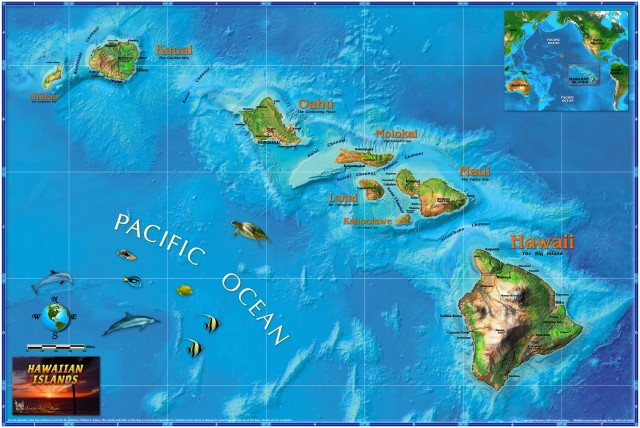The State of Hawaii
AT A GLANCE
Name: The origin of the name Hawaii is uncertain. The islands may have been named after Hawaii Loa, the chief who has traditionally been believed to have discovered them, or they may have been named after Hawaii or Hawaiki, the traditional home of the Polynesians.
Nickname: Aloha State
Capital: Honolulu
Size: 6,459 sq. mi. (16,793 sq km)
Population: 1,431,603 (2015 est)
Statehood: Hawaii became the 50th state on August 21, 1959.
Electoral votes: 4 (2016)
U.S. Representatives: 2 (until 2016)
State tree: kukui (candlenut)
State flower: yellow hibiscus
State bird: Hawaiian goose
Highest point: Mauna Kea, 13,796 ft. (4,205 m)

THE PLACE
Hawaii is the world's longest island chain, with 124 islands. Hawaii is located 2,090 miles (3,344 km) west-southwest of San Francisco, California. Each island is made up of at least one primary volcano, although many islands are composites of more than one. The eight largest Hawaiian islands are Hawaii, Kahoolawe, Maui, Lanai, Molokai, Oahu, Kauai, and Niihau. Of these eight, only Kahoolawe has no permanent inhabitants. The island of Hawaii is the largest.
Honolulu, the state capital, is on Oahu. The remaining islands consist of islets of rock in the middle of the chain, as well as coral and sand islands in the northwest. The climate on the eight main islands is rainy and warm. Most of these islands have fertile soil, which enables their inhabitants to grow many kinds of tropical products.
Hawaii has few natural resources. It also has little native wildlife, but most of its animals and plants are unique in the world.
Facts and Firsts
- Hawaii is the only state formed entirely of islands and not attached to continental North America.
- From east to west, Hawaii is the widest state.
- Hawaii has its own time zone, Hawaiian Standard Time. It is two hours behind Pacific Standard Time.
- Hawaii is the only state that was once a royal kingdom. Today, Iolani Palace on the island of Oahu is the only royal palace in the United States.
- The Hawaiian Islands were formed thousands of years ago by volcanoes that erupted under the sea. The islands are the tops of these undersea volcanoes.
- Hawaii grows more than one-third of the world's supply of pineapple, and it is the only state that grows coffee.
- The Hawaiian alphabet has only 12 letters—A, E, I, O, U, H, K, L, M, N, P, and W.
THE PAST
Hawaii's past is as colorful as its landscape. Polynesians, who sailed in canoes from other Pacific Islands sometime between A.D. 300 and 600, first settled the islands. The first European to explore Hawaii was British captain James Cook, who landed there in 1778. When Cook arrived, Hawaii was a monarchy controlled by Polynesian kings.
In 1835, the first sugarcane plantation in Hawaii was started, and in the 1880s pineapple became another major crop. Chinese, Japanese, and Filipino immigrants began to move to Hawaii to work on the sugar and pineapple plantations.
As Hawaii became more agriculturally valuable, U.S. involvement in its business and politics increased. In 1893, the last Hawaiian queen was removed from the throne, and Hawaii became a republic. In 1900, Hawaii became a U.S. territory. During World War I, the U.S. military built a naval base at Pearl Harbor. Years later, the Japanese attack on Pearl Harbor on December 7, 1941, drew the United States into World War II. Only after the war, when Hawaiians had proved their loyalty to the United States in a number of battles, was the territory admitted as a state.
THE PRESENT
Today, tourism is Hawaii's most important industry. More than 6 million people visit the islands every year. Hawaii's beaches, mixture of cultures, and warm climate draw people from a variety of countries.
Tourism, however, presents Hawaii with a number of challenges. The state must balance the needs of its many tourists with its own ecological necessities. Many of Hawaii's native animal and plant species are endangered, and the expansion of tourism puts Hawaii's land at further risk.
Pineapple is an important crop, and the islands also grow coffee, bananas, sugar, flowers, and macadamia nuts. Aquaculture—the raising of fish and shellfish—is expanding. Manufacturing, especially food processing such as sugar refining and pineapple processing, help round out Hawaii's economy.
Born in Hawaii
- Salevaa Atisanoe (Konishiki), sumo wrestler
- Tia Carrere, singer and actress
- Jean Erdman, dancer and choreographer
- Hiram L. Fong, first Chinese American senator
- Don Ho, entertainer
- Duke Paoa Kahanamoku, Olympic swimming champion
- George Parsons Lathrop, journalist and poet
- Bette Midler, singer and actress
- Ellison Onizuka, astronaut
- Harold Sakata, actor